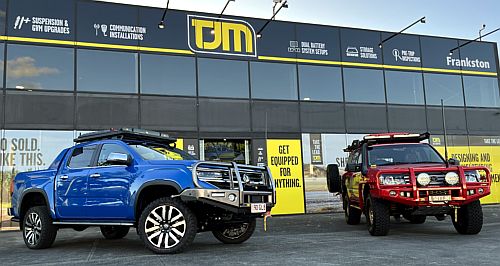Solid footing secures positive outlook for TJM

TJM is undoubtedly the second most well-known, three-letter, four-wheel drive brand in Australia, and one that is growing at an impressive rate. But with electric utes beginning to make their mark, and global regulations around auxiliary frontal protection tightening, the future of dominant players in the arena may be at risk.
We are speaking to Aeroklas Asia Pacific Group (the parent company of TJM) chief executive officer, Greg Kelly, at this week’s TJM’s Volkswagen Amarok accessories line unveiling, and it is apparent the off-road accessories market is booming, with TJM setting its sights on an even more extensive range developed more closely with the OEM, and on markets not only in other countries, but that may not yet exist.
“It is interesting when we sit down with some of our engineers – especially some of the younger engineers – and discuss what the future might look like, and it might surprise you to know that they’re already looking quite a way out, 10-, 12- or even 14 years out,” he explained.
“Of course, that’s a great challenge, especially as electric vehicles come on stream and as regulations change. But we do have a wonderful innovation stream that is supported by some of the best engineers we have.”
Mr Kelly said that with electric utes a reality none in the business can afford to ignore, considerations beyond traditional front protection must now form part of the engineering mix, especially as weight and design considerations, and vehicle-to-vehicle and vulnerable road-user requirements become more relevant.
“We already have a number of products in development that will essentially improve the design and reduce weight without compromising on structural integrity. Within the Aeroklas Group, there is a very strong focus on innovation, and our partnership with EPG (Eastern Polymer Group), which in my view is one of the most innovative polymer groups in the world, there is, shall we say, a lot of focus on that,” he grinned.
“Of course, I can’t comment on timing just yet. But the worry is that we’re always one regulation change away from needing to make that change – a very significant business change. We’re very conscious of what has happened in Europe and that we might have to have products (like polymer-based bullbars) developed and ready to go.”
While plastic and polymer bars are nothing new, Mr Kelly explained that consumer acceptance of such products may well alter if regulations change – or once electric pick-ups become more commonplace in the market.
He said the TJM team has recently toured some of the most challenging four-wheel drive tracks in the United States in a Rivian R1T to see not only how the vehicle performs, but what future protection and accessories items might look like for electrified off-roaders.
“Think about what a bullbar is designed for – it is there to protect the radiator and other vital elements in the event of an animal strike or similar so that the vehicle can continue to operate, and that is especially important in Australia where you might need to cover a vast distance before being able to make repairs,” he detailed.
“But in the case of an electric car, you have to ask, what is the bullbar really protecting… and we really need to match that consideration with the design of the vehicle, future ADAS technologies, its appearance, and of course what the customer demands.
“We will develop products that perform as good or if not better than a customer expects, but with a reduced weight. And it might be that the frontal protection will be more for mounting accessories or to offer a level of uniqueness in addition to protecting any vital electronic, structural, or mechanical components.
“As I said, predicting where the future might lead us is always a challenge.”
In the more immediate term, the TJM team has plenty to keep it busy. Selling into 116 markets, and with a parts catalogue that challenges the best in the business, it is continuing to work closely with manufacturers to ensure new products are available in a timely fashion.
Interestingly, Mr Kelly was quick to point out that while customer tastes and statutory guidelines changed slightly from region to region, Australian-developed products remain well regarded, particularly in the United States.
“Our approach is a global approach, and one of the things that is driving it is that Australians are genuinely – and for a long time – regarded as leaders in off-road equipment and off-road development; and that’s partly because Australia is such a great proving ground,” he said.
“Australia not only has some of the harshest conditions in the world, but we have some of the best engineers. They really know these products. When we look at the overlanding explosion that’s happening in the US, and the feedback we’re getting on our product, those in the business say the US is still at least 10 years behind what we’re already doing.
“There is a real desire for Australian designed and developed products, and not just in the United States. We sell into 116 countries around the globe, and we are at the forefront of off-road product development. I think we have really helped to lift the profile of the Australian product portfolio and drive-up profits,” he added.